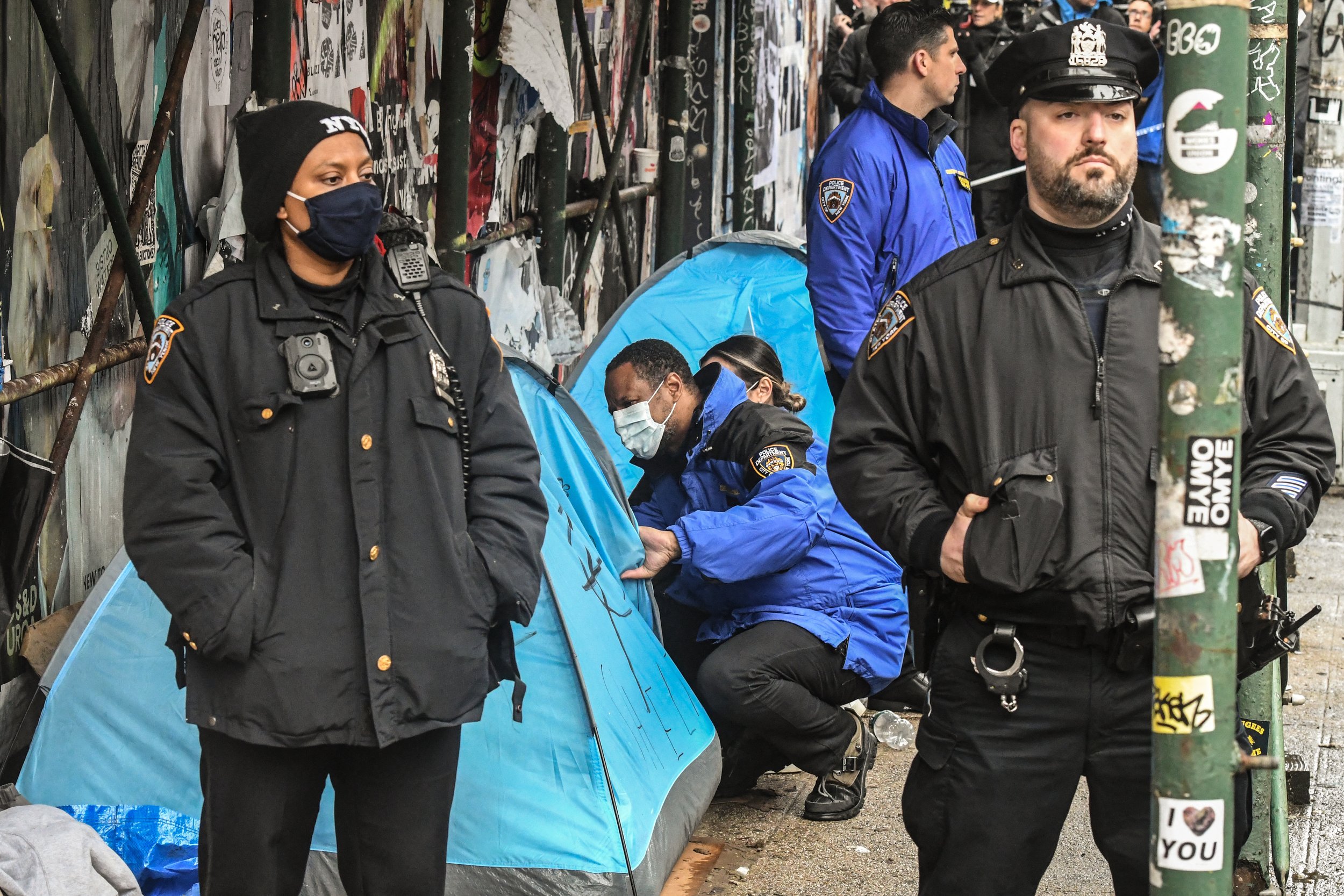The Police Are Really Bad at Solving Crime
The NYPD clears a homeless encampment near Tompkins Square Park, New York City on April 6, 2022. [Stephanie Keith/Getty Images via AFP]
By Marian Jones
On April 12, a 62-year-old man named Frank James stunned New York City when he detonated smoke bombs and opened fire on a crowded subway car in Brooklyn, injuring 29 people but killing none.
The hapless manhunt that ensued exposed not only police incompetence, but raised plenty of questions about what police really do with their time.
The NYPD has the country's largest budget ($10.4 billion), 36,000 cops and officers for every subway station (3,250 transit police). But, despite all of these resources, they were still unable to arrest the gunman. According to multiple news outlets, one officer at the scene of the attack couldn't get his radio to work and asked civilians on the platform to call 911. None of the security cameras at the 36th Street station, where the shooting occurred, were functioning properly.
The gunman left so many clues that some likened him to the Riddler, who intentionally leaves riddles that, if cracked, would lead authorities right to him. The first was forgetting the key to a U-Haul van he had rented under his own name on the train – as well as the credit card he used to rent it. Even so, James still eluded capture for more than a day.
What ended the manhunt? Did police, as NYPD Commissioner Keechant Sewell said, leave “nowhere left for him to run”?
Evidently, James got bored of waiting and called in a tip on himself. Yet he was only apprehended when Zack Tahhan, a 21-year-old Syrian immigrant and security camera technician, saw a man who matched police photos walking down the street in the East Village. The Brooklyn subway shooter was found by an everyday, working-class New Yorker.
This highlights a larger problem: Most people mistakenly assume that police solve crimes on a daily basis. According to University of Utah law professor Shima Baughman's research, just 11% of significant crimes end in an arrest and 2% in a conviction. A significant proportion of serious crimes usually remain unsolved.
What are police doing instead? Most cops spend between 46% and 81% of their time on “unassigned” duties, such as eating lunch or filling out paperwork. And when they’re on patrol, cops playing with their phones has become such a problem that even Mayor Eric Adams, a former cop himself, has expressed his “frustration.” Two weeks after the subway shooting, Adams asked New Yorkers to send him photos of officers using their phones while on duty. “We are going to start taking very aggressive actions to make sure police are patrolling our subway system and not patrolling their iPhone,” the mayor warned.
Public perception of police in the United States has for decades been dominated by the misleading image of the warrior officer, even though police spend most of their time responding to noncriminal calls like traffic incidents, and minor crimes. Only a small percentage of time is spent responding to violent crimes in a given shift.
This reality is not reflected in police training and recruitment. Police officers are disproportionately drawn from the military, where they were educated and trained in institutions that prioritize violence and law enforcement, as per Vox.
Since taking office, Adams has resisted abolitionist demands to defund the police and fund social services instead. (One thing many people can agree on is that cops should not be filling the role of mental health professionals and social workers.) In fact, he has attempted to reinstate contentious law enforcement tactics such as restoring the plainclothes unit that was responsible for Eric Garner's killing (as well as for "stop and frisk") and the use of facial recognition technology that has been criticized for inaccuracy and for being disproportionately deployed against nonwhite New Yorkers.
In the wake of the shooting, Adams revealed plans to increase police presence in the subways and install metal detectors at stations. No evidence exists to link more cops to increased safety, experts say. Data shows no correlation between spending millions of dollars on police and lowering crime or increasing public safety.
So what is the real purpose of the police? Reporter John Teufel, who follows Adams closely for New York publication The Indypendent argues that Adams accurately sees the police as protectors of private property and business interests. While James was waiting for the cops to find him, the NYPD's anti-terrorism unit, the Strategic Response Group (SRG), was busy dismantling homeless encampments.




